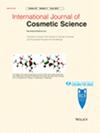New insights into hair compartments swelling via atomic force microscopy and dynamic vapour sorption
Abstract
Objective
Preliminary investigations into the swelling of human hair upon absorbing moisture have been performed to better understand the roles of the various hair morphological subcompartments and their response to moisture.
Methods
The isotherms of moisture sorption exhibited by hair were recorded via Dynamic Vapour Sorption (DVS) for separated cuticle and for cortex. Atomic Force Microscopy (AFM) imaging and nanoindentation were used to follow the changes in measured distances on the same areas of cuticle layers and cortex cells from a single fibre cross section, and to evaluate the change in these distances with changes in relative humidity.
Results
The data acquired by DVS moisture sorption and by AFM for the various morphological components of the hair fibre allowed for the evaluation of their swelling. The values were then used for estimating the cross-linking density of each morphological component. A relationship between the mechanics of the cortex and the cuticle of the fibre and their cross-linking density values was found to follow logarithmic-like dependencies. The size of the crosslink meshes at 90% RH was also evaluated and found to be of the length of the stretched disulfide bond.
Conclusion
The analysis of hair swelling provides information on the crosslinks inside the fibre. The models used for calculating the crosslink density and the size of the meshes, as well as the relationship suggested graphically between the crosslinking density values and Young's Modulus, point to cystine as the decisive factor in the swelling process; the different amounts of cystine in each morphological component lead to different values of their crosslinking density and to their differing responses to mechanical stress.


 求助内容:
求助内容: 应助结果提醒方式:
应助结果提醒方式:


